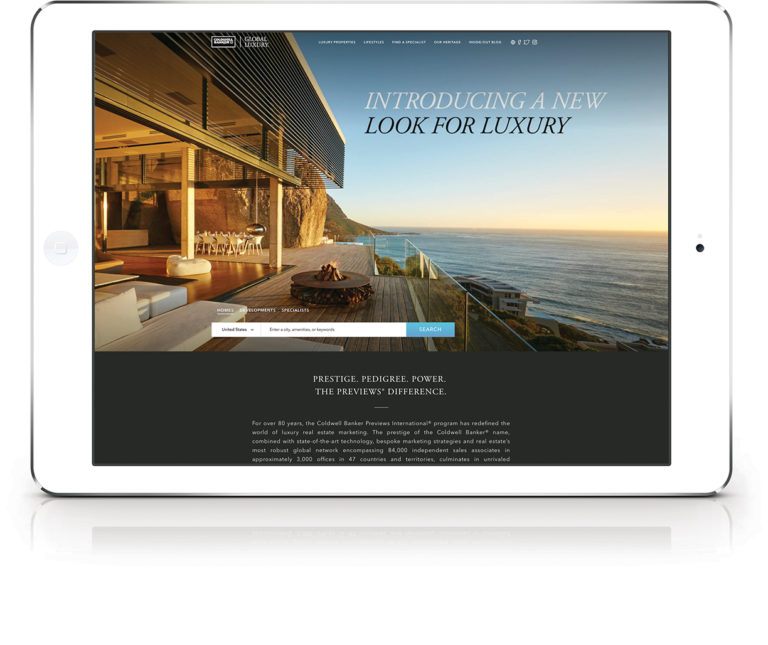They’re going fast! Mountain Shadows’ new resort condominiums and suites are flying quickly off the market, with only 13 of the 42 units remaining. These brand-new condos in the luxury wing of Mountain Shadows in Paradise Valley, Arizona mark the completion of the $100 million new-build resort in March 2018.
Sitting at the foot of Camelback Mountain, Mountain Shadows Resort Condominiums is the first three-story resort residential building in Paradise Valley, designed for those seeking “lock and leave” resort-style living. Direct access to the entire Mountain Shadows resort encourages owners to take advantage of incredible amenities and resort perks, such as housekeeping, valet and concierge services, access to the wellness-centric Citizens Club and juice bar, and access the only 18-hole, par-3 golf course in Arizona. The Mountain Shadows Resort Condominiums offers studio, one-, two- and three-bedroom floor plans, ranging from 1,000 to 3,410 square feet and priced from $840,000 to $4.1 million.
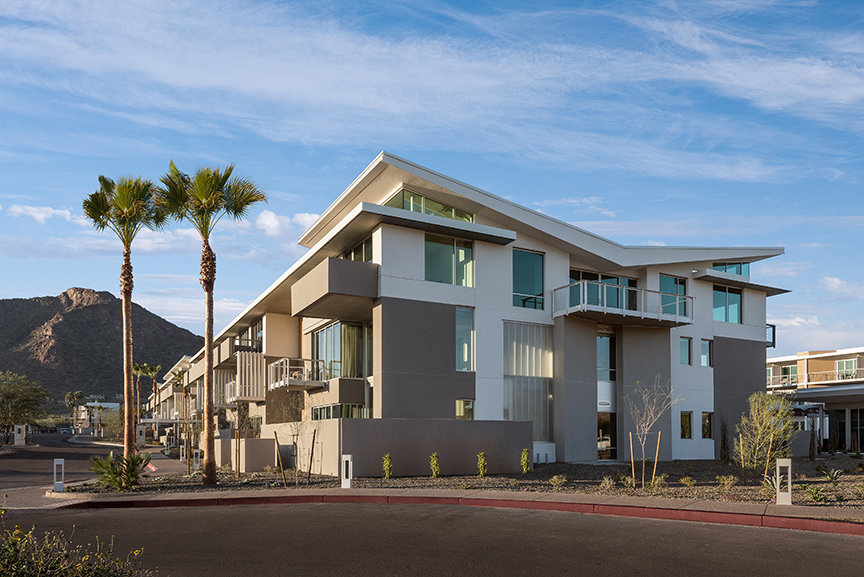
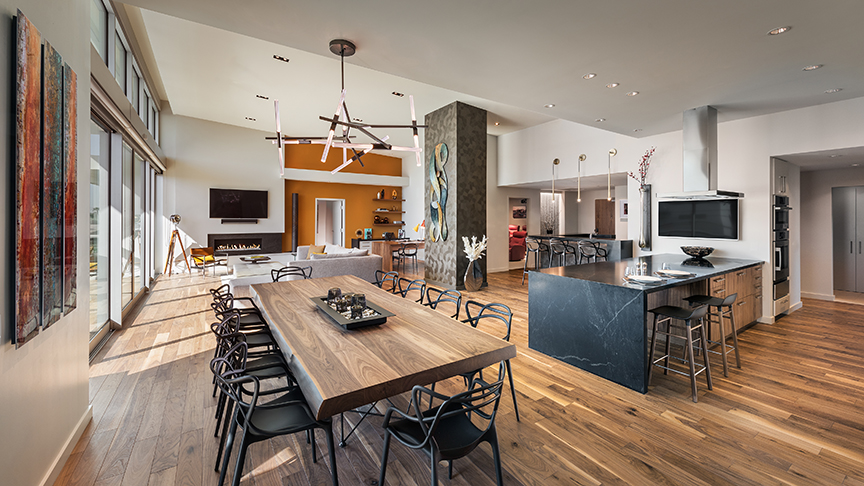
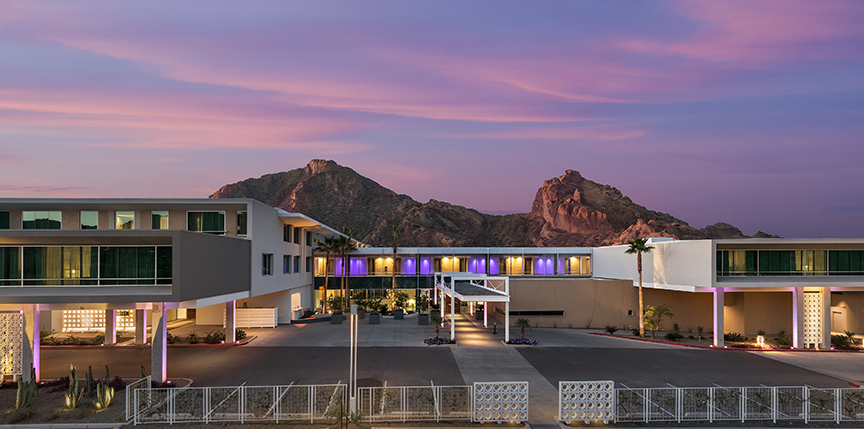
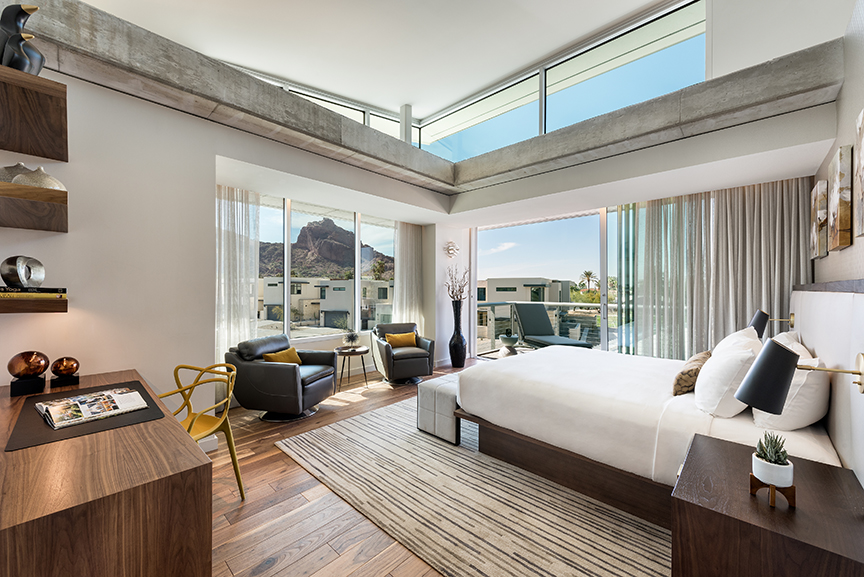
Designed by Scottsdale-based Allen + Philp Architects, each condo and suite at Mountain Shadows Resort Condominiums is a personal retreat for residents to rest among the best of mid-century modernism and contemporary design.
An icon of the desert, Mountain Shadows is an upscale boutique resort, with its roots in 1950’s modernism. The original property closed in 2004, replaced by a $100 million new-build resort by acclaimed developers of Sanctuary on Camelback Mountain Resort & Spa and Hotel Valley in April 2017. A brand new fitness center and outdoor pool unveiled during the opening, called The Citizens Club, a high-tech fitness center offering an array of 60-minute classes, and two 75-foot pools, connected by a modern waterfall feature and dramatic views of Camelback Mountain and the surrounding desert beauty.
Photos courtesy of Mountain Shadows
Artist and inventor Bandana Jain works with recycled and eco-friendly materials to create one-of-a-kind artwork for the home.
Sharing a deep concern for the environment, the contemporary artist has been creating artwork using corrugated cardboard for the last seven years. She crafts unique furniture for clients — from couches and desks to tables and lamps.
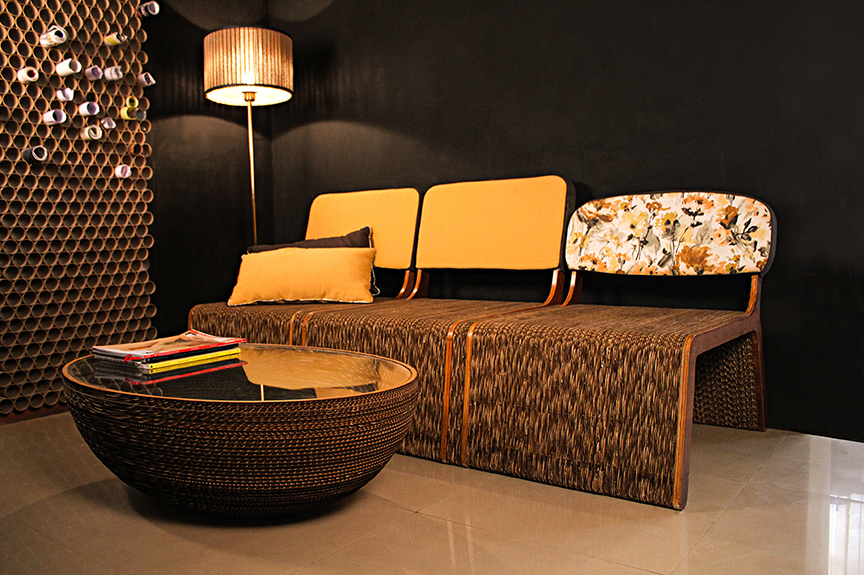
She is also the founder of Sylvn Studio, a business dedicated to conserving the environment. The India-based business is the country’s only design label specialized in hand-crafted décor products made of recycled corrugated cardboard.
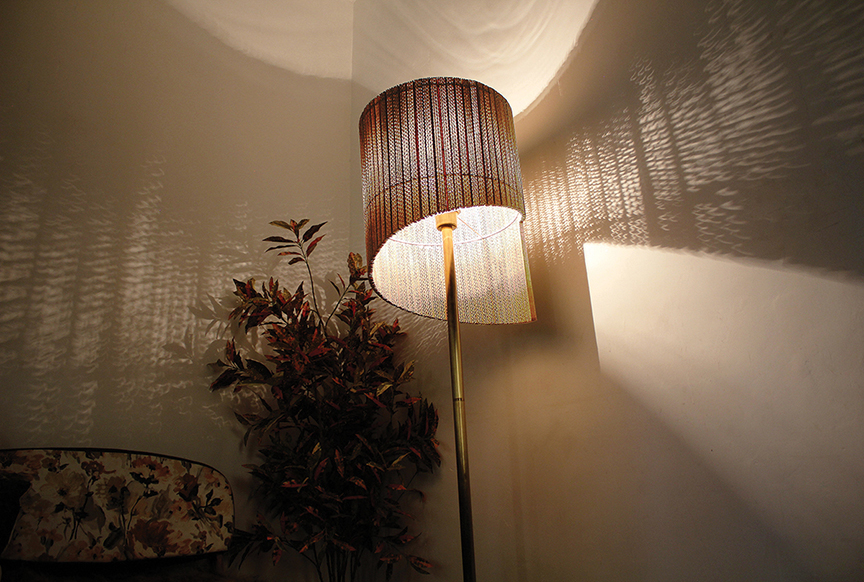
How did you first begin your work with cardboard? Why did you choose this medium?
Initially, I worked with a few other mediums. To choose cardboard as a signature medium was a conscious decision I had taken because I wanted to offer something different. Also I wanted to educate people about adopting sustainable lifestyle.
How has your journey with this medium shifted in the last seven years?
It only grew with time. Corrugated cardboard is certainly not an easy medium to work with. I struggled a lot and over time I gathered experience and maturity to handle this medium. I must say nobody can touch me now.
Why is it important that designers/artists use recycled and eco-friendly mediums and that homeowners choose to purchase these types of artwork?
We are all the children of the earth. The existence of our being is intrinsically connected to nature. As responsible humans, it is for us to ensure that we build a better place for ourselves and subsequent generations to come. This can happen only when we make the right choice.
Why should homeowners incorporate these pieces into their homes?
A well-designed interior accessory revs up the design quotient of your abode. And every accessory in a home is akin to an individual chapter in the overall design narrative. It defines the space and tends to be a conversation starter because of its exclusivity and aesthetics. Who doesn’t want to be talked about?
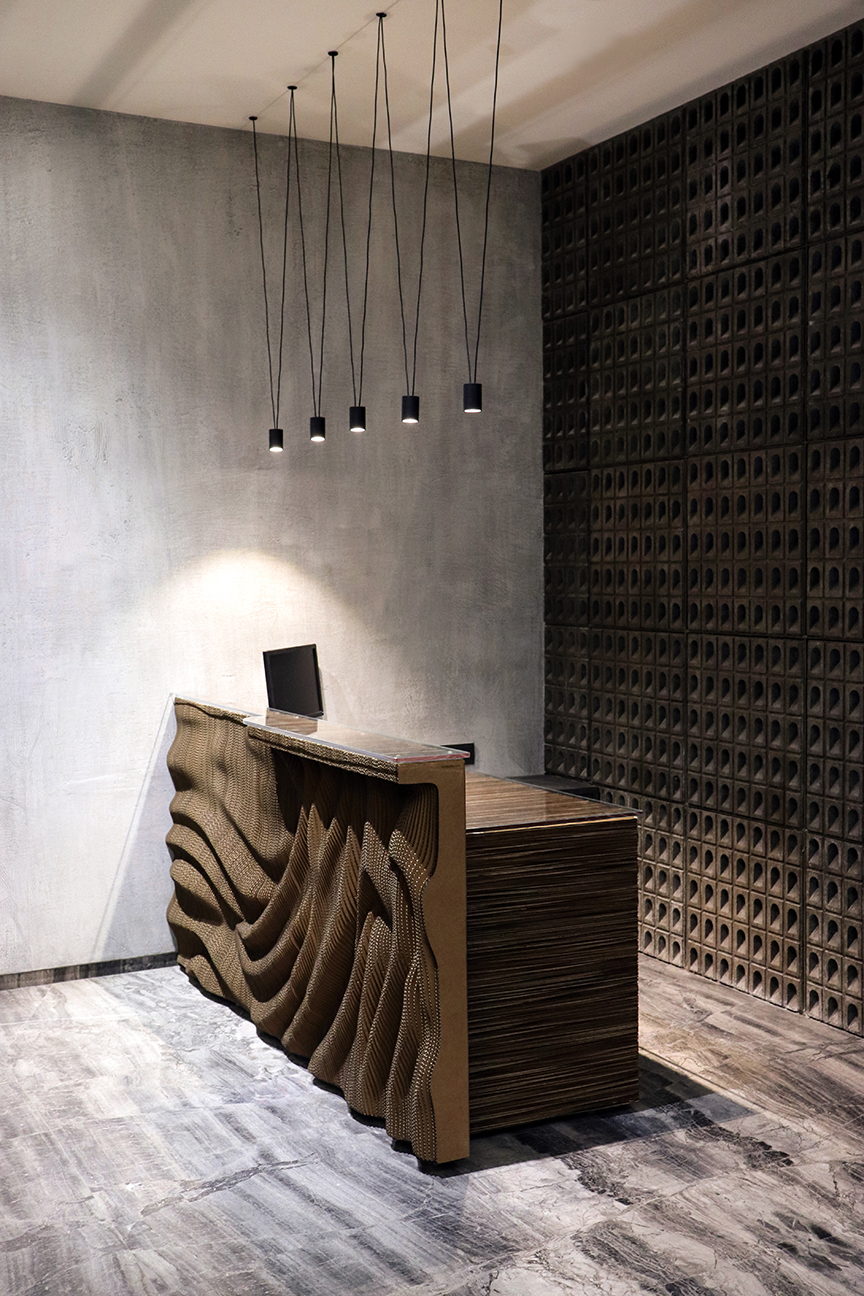
Where do you gather inspiration for your creations?
Inspiration comes to me from a myriad of spaces. As an artist, my observations and experiences guide me. My choice of medium is also a part of my experience. Once I was in Zermatt where I had the chance to explore the Eco Village; the determination of the locals to keep the town sustainable inspired me a great deal.
Photos courtesy of Bandana Jain
Contemporary versus Farmhouse. Warm woods versus stark whites. The latest kitchens incorporate new ways of thinking.
By Camilla McLaughlin
The kitchen story continues to be painted in white and grey, but for luxury the narrative is changing. “When it comes to high-end luxury, it’s about quality. It’s about finishes, color and the wow factor,” says National Kitchen & Bath Association Industry Relations Manager Elle H-Millard, who is also a certified kitchen designer, noting that luxury continues to be more about the user experience.
There is no better place to scope out what’s ahead for kitchens than the industry’s annual trade event, the Kitchen & Bath Industry Show. Although the focus might be the overall kitchen market, many of the trends and innovations are ideally suited for the largest budgets and savviest design aspirations.
Still, Christopher Grubb, president of Arch-Interiors Design Group in Los Angeles, points out that luxury today speaks to multiple tiers in the market. “Luxury doesn’t have to be about cost. Luxury is an experience, and at every price level people want luxury finishes.”
White and grey remain the preferred color schemes according to the vast majority of design experts and industry professionals responding to NKBA’s annual trends survey. Still, anyone walking the KBIS show floor this January couldn’t help but notice that wood in medium to light tones was very much in evidence, either for cabinets — especially in contemporary designs — or as an accent. “I am seeing a lot of movement because grey and white have been so popular. I am seeing wood tones come back, which is kind of nice. We haven’t seen that in a while,” observes Grubb. The emergence of wood, either as a primary finish or as an element in a design scheme, reflects a subtle shift and growing desire to integrate an organic feeling.
Typically, styles gain or lose momentum over an interval of several years. This year, Farmhouse suddenly jumped to the top in the NKBA survey with 79 percent of design professionals characterizing it as “trendy” or “very trendy.” This eclectic style mixes white with warm metals and mellow weathered wood. Reclaimed wood beams and hardwood flooring along with barn doors and apron sinks enhance the Farmhouse sensibility.


Transitional, which combines clean lines and streamlined traditional details, was the second most preferred style. Main elements of this style include quartz countertops and wood floors.
Overall, for countertops in every style, H-Millard says, “quartz is where it’s at today;” 94 percent of professionals surveyed agree. Hardwood was the preferred flooring, according to 78 percent of respondents.
Contemporary, defined by linear forms with flat-front doors and frameless cabinets, followed as the third-most-preferred style. Hallmarks include open shelving, clean lines and appliances that meld into cabinets. It’s important to note the narrow spread in the survey between Farmhouse at 79 percent and Contemporary at 73 percent.
Dark tones continue to find their way into kitchens in faucets, hardware and cabinets, sometimes as a contrast with white. For cabinets, blue is emerging, and black is gaining traction for both faucets and cabinets. Glossy finishes are out; matte is trending. A matte surface, combined with processes that highlight grain and create a textural finish, imparts softness and depth that creates almost a tactile sense. It’s not an overstatement to call this “the new black.”
The desire for customized storage shifts more attention to what’s inside cabinets and drawers, especially in the high end. Every year manufacturers expand the number of inserts and products designed to enhance organization, meet everyday cooking requirements and adapt kitchens for a range of cuisines, special interests and abilities.
“One of the things that came out of the luxury custom movement is really creating an experience for the user,” says H-Millard, who sees more and more companies tapping into the human touch, offering ways to customize products.



This year, Elkay introduced an option offering various front panels for their farmhouse sinks, which allows consumers to change the look of the sink. Pops of color are another hallmark of high-end kitchens, and H-Millard says a growing trend is the use of bold colors to make large gas ranges the focal point of a kitchen. Often too, manufacturers give consumers ways to change the look with panels in multiple colors that can be switched out. “They are making new colors every year. There are so many options to choose from in bold pops of colors, everything from knobs, materials and finishes. That alone is really kicking the personalizer for the user experience to a whole new level,” explains H-Millard.
For refrigerators, Tami Catalano, sales consultant with Monark Tucson Showroom, says it’s about “columns, columns and more columns. We have just about every brand offering columns now. It’s about who can dress them up more, be more flexible or offer the most competitive price point.” Having the option to create whatever configuration a homeowner desires and seamlessly integrate it into a custom design completely personalizes this appliance. Manufacturers continue to offer new takes on stainless, but Grubb says for high-end kitchens typically the choice is a paneled finish that matches the cabinets, so the appliances blend in and make the kitchen appear larger.
Sinks are on the cusp of morphing into the most versatile product in the kitchen. Not only are large format styles in demand, but manufacturers offer many ways to configure a sink along with accessories that maximize function. Often a sink can be combined with under-cabinet refrigeration. An induction burner adds an option to cook pasta or lobster next to the sink. Multiple bowls also make the sink a spot to ice drinks or seafood. H-Millard says, “This is a whole new way of thinking, which will drive new traffic patterns in the kitchen.” Even the traditional work triangle is being tweaked by large islands. A standard U- or L-shaped plan is now focused on the island, and H-Millard expects this to change the configuration of cabinetry. “It is also going to change how people look at functionality in their kitchens,” she says. Mid-height cabinets should gain traction.
For next-generation kitchens, look for a growing interest in wellness and freshness to spark a new wave of innovations.


Photos courtesy of Laurent Levant Interior / Dave Bryce Photography, istockphoto.com / Hikesterson, Taryn Emerson Interiors / Jared Bumgarner, Haffle America Co., Mike Tuell, Arch Interiors / Greg Weiner Photography
From cozy getaway bungalows to spacious retreats for epic gatherings, this inspiring collection of mountain-modern homes is redefining what it means to live amongst nature.
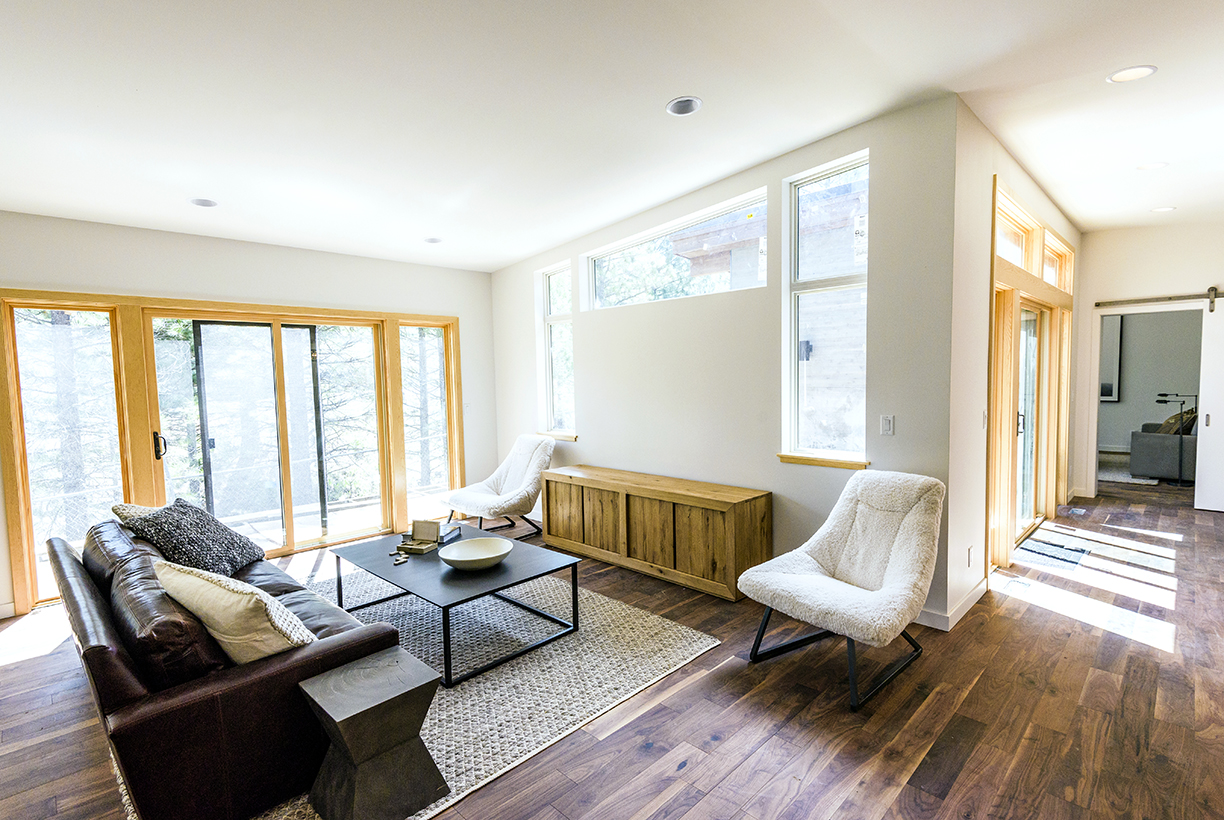


Nakoma Resort, located just a 45 scenic miles north of Truckee in a vast landscape of mountains and lakes, has debuted Ascend at Nakoma. These luxe modular homes are the result of a unique collaboration between Grouparchitect, Method Homes and Mark Tanner Construction.
In addition to utilizing the latest in green manufacturing principles and boasting generous indoor/outdoor living, each home was designed with mountain-modern style in mind. With the increasingly popularity of mountain-modern design, we spoke with Greg Traxler, SagePoint sales director, to explore the trend further.
Can you define what “mountain-modern” style means to you?
Creating a connection to natural settings and embracing the outdoors. We have large windows to let the outside in along with generous outdoor living spaces. Building homes that utilize the latest in green manufacturing principles is key too. Our interior program for our turnkey offerings are designed and furnished by RH, Restoration Hardware.
How can one merge these two very different concepts: mountain-style and a modern look?
Partnering with our design and construction teams has helped create exciting blends of styles and materials to create the mountain-style and modern look. They are all firms very much in touch with the delivering residences that are stylish, fitting and comfortable.


Why do you think this type of design is popular right now?
Mountain modern has emerged as today’s most popular architectural style, widely adopted across the U.S., not only in the mountains but also all resort and urban settings.
What are some elements that are essential to creating this style?
These residences are decorated and customized by the Nakoma team and Restoration Hardware. The furniture and accessories from the Restoration Hardware design team reflect the very best in today’s trend setting market — all tailored for practicality and durability, but also to be warm and inviting in every season.
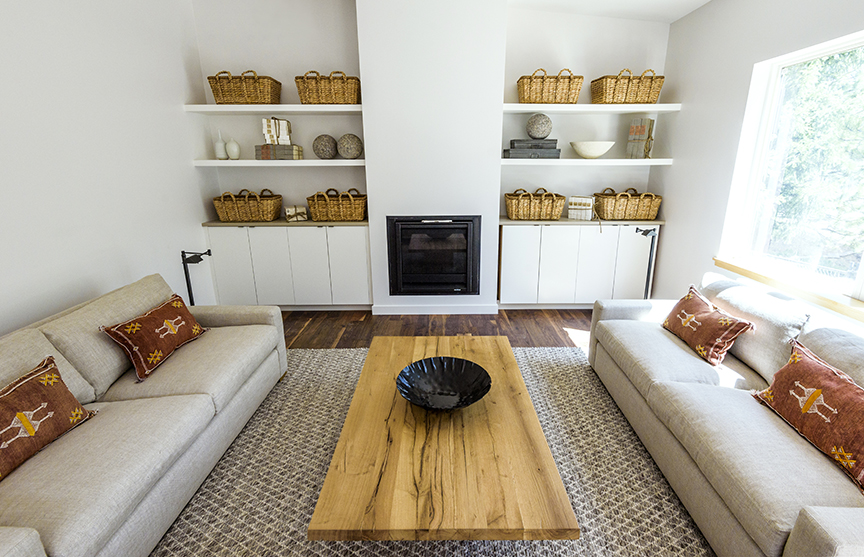
Artfully integrating into today’s modern hospitality environments, Sans Hands faucets use electromagnetism to streamline the hand washing process and reduce the spread of disease and bacteria.
By Brielle Bryan
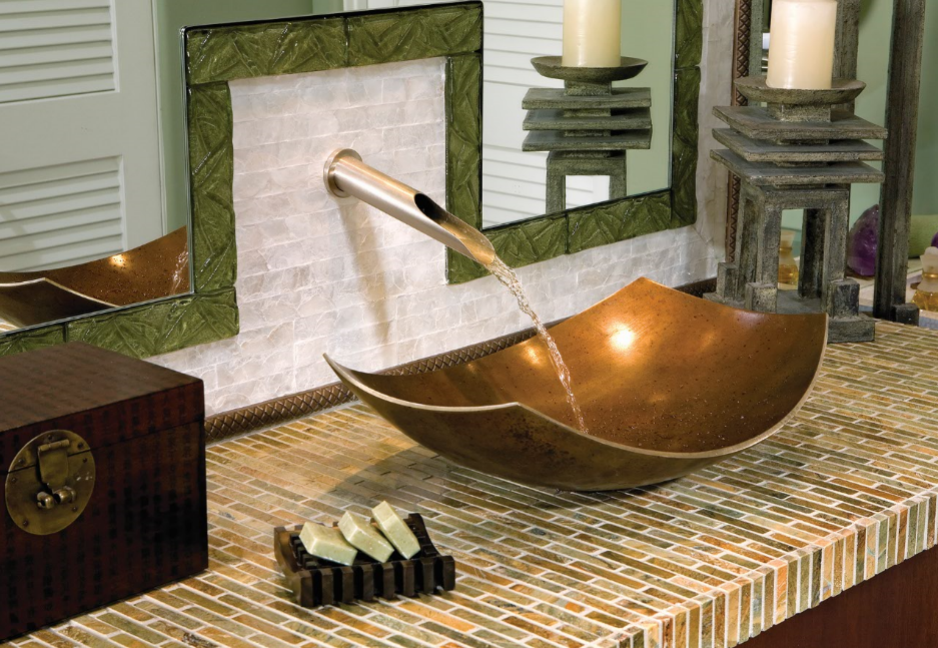
Driven by growing concern over germs and bacteria on restroom surfaces, more hospitality environments are turning to hands-free, automated faucet technology. Sonoma Forge, located in Sonoma County, California, combines craftsmanship and skilled metalwork with its unique line of designer faucets, tub fillers, shower systems and coordinated bath accessories.
Sans Hands, Sonoma Forge’s sensor faucet technology, offers an improvement over outdated infrared technology with its invisible sensors. Sans Hands incorporates an electromagnetic proximity sensor, and is packaged in stylish designs that perfectly fit today’s modern industrial style.
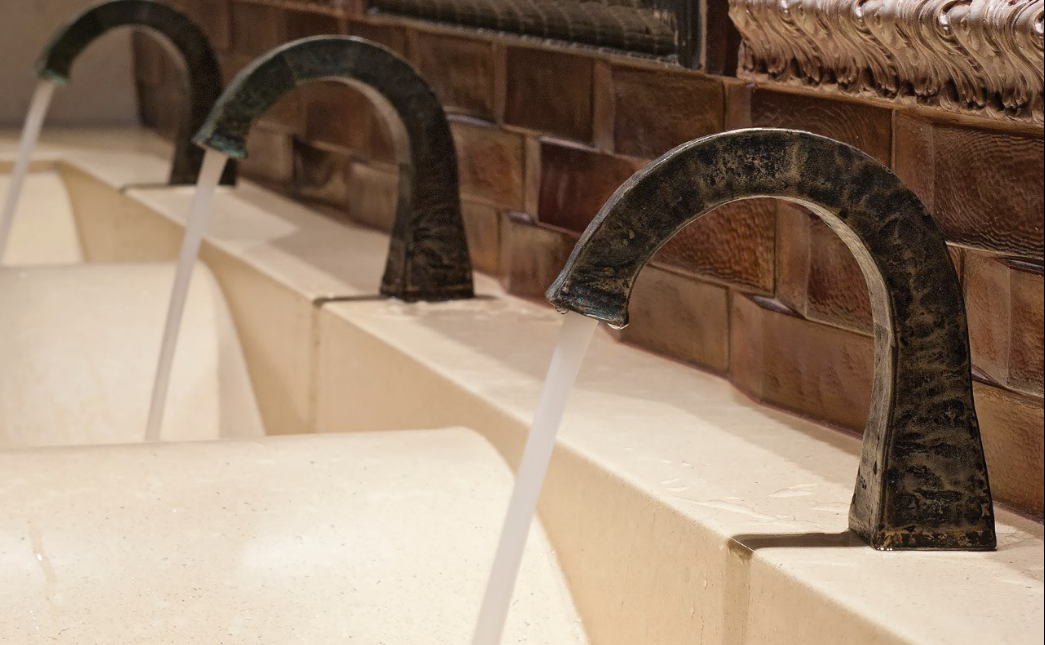
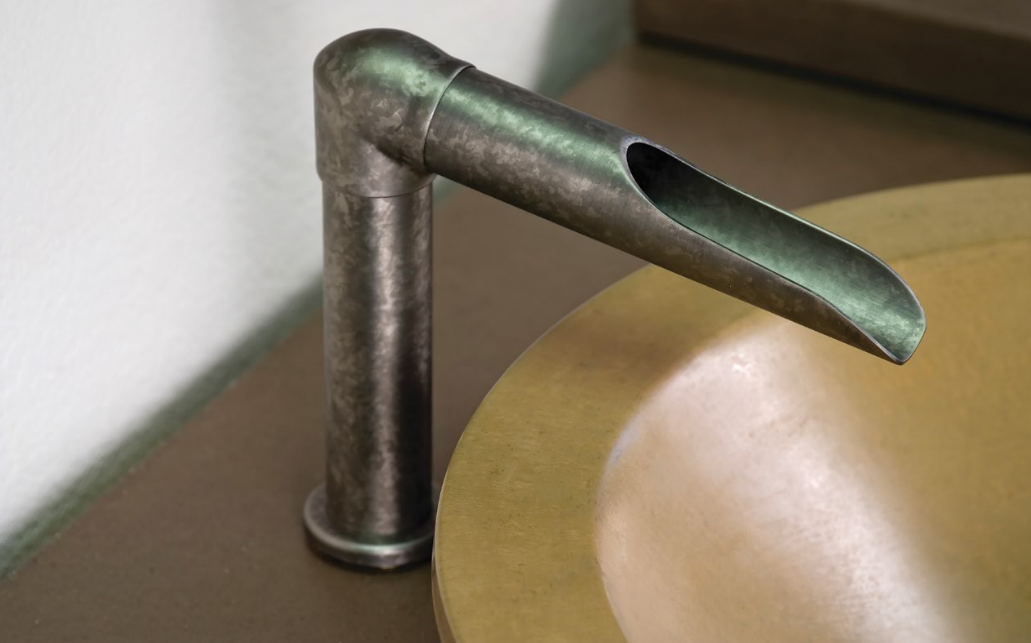
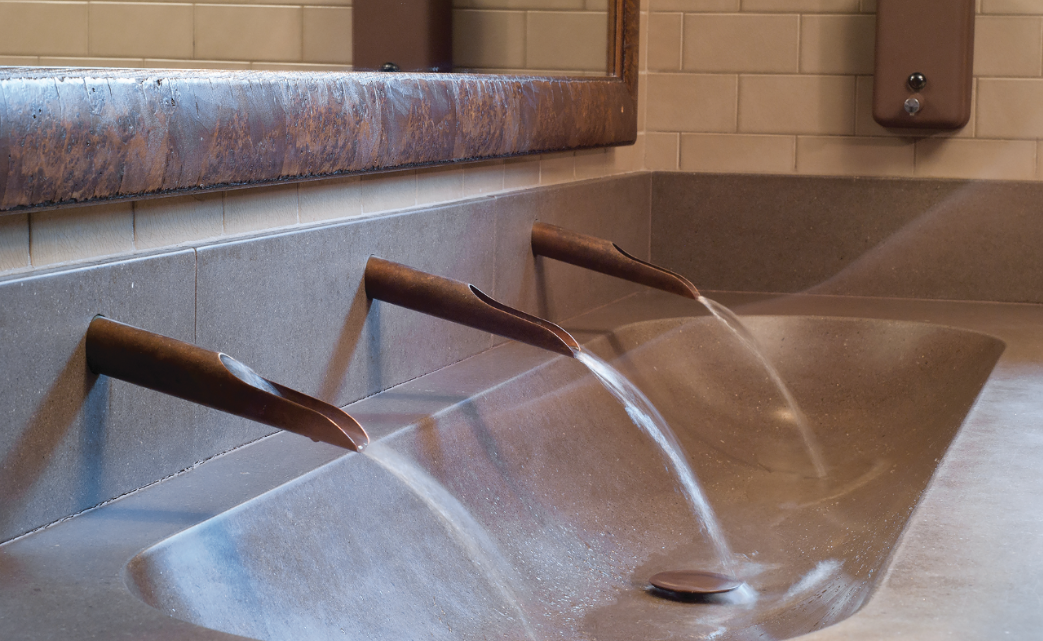
“Rather than relying on old, unreliable infrared technology, Sans Hands allows users to skip the frustration of frantic hand waving and enjoy the stylishly unique bathroom décor,” said Erik Ambjor, president of Sonoma Forge.
Sans Hands faucets use the basic principle of electromagnetism. Simply speaking, the components include a spout, a low-voltage current from an electrical source — either battery or plug-in — and an electronic brain supplying an electromagnetic field to the spout. When a user approaches the faucet, the electromagnetic field is interrupted, which opens and closes the valve.
Sans Hands faucets are handcrafted and assembled by skilled artisans. They also come in wall-and-deck-mount configurations and are available in a wide array of finishes. A suite of coordinating bath accessories, including decorative hardware, towel bars, tissue holders, mirror mounts and more complete the industrial look. The refreshing design options offer homeowners a decidedly masculine sense of style that enhances any setting, whether urban loft, country villa or boutique hotel.
Photo courtesy of Sonoma Forge
This article originally appeared in the Spring 2017 Edition of Homes & Estates Magazine.
With an eye toward the future, one of real estate’s most iconic brands boldly remakes its luxury marketing program and unveils a brand-new identity.
By Alyson Pitarre

Versace. Aston Martin. Tiffany. The common thread between all of these brands? Staying power. They have all dared to adapt, to refine the picture of who they are and to lead by continually raising the bar for future generations.
Leadership in luxury real estate does not come easy. Globalization and new technologies have continued to challenge the status quo at the highest price points, while competition has grown even fiercer as the luxury residential sector led the recovery from the Great Recession. In the battle for market share, where new players are entering the picture and existing competitors are continually jockeying for position, the leader always has the most to lose…
CLICK HERE FOR THE FULL STORY AS SEEN IN THE SPRING 2017 ISSUE OF HOMES & ESTATES.
